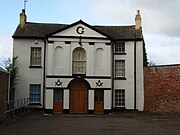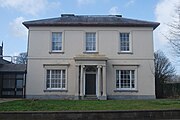George Vaughan Maddox
George Vaughan Maddox | |
|---|---|
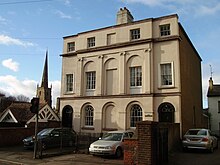 Kingsley House (left), built to Maddox's design and his home for much of his life | |
| Born | 1802 |
| Died | 27 February 1864 (age 61/62) Hempsted, Gloucestershire |
| Occupation | Architect |
| Years active | 1820s–1840s |
George Vaughan Maddox (1802–27 February 1864)[1] was a nineteenth-century British architect and builder, whose work was undertaken principally in the town of Monmouth, Wales, and in the wider county. Working mainly in a Neo-Classical style, his extensive output made a significant contribution to the Monmouth townscape. The architectural historian John Newman considers that Monmouth owes to Maddox "its particular architectural flavour. For two decades from the mid-1820s he put up a sequence of public buildings and private houses in the town, in a style deft, cultured, and only occasionally unresolved."[2] The Market Hall and 1-6 Priory Street are considered his "most important projects".[3]
Life and works[]
Maddox was born in 1802, the son of another architect, John Maddox,[4] who also worked in the county. Maddox designed some of Monmouth's most notable buildings, including the Market Hall,[5] "his major work",[6] the Beaufort Arms Hotel,[7] the Methodist Church,[8][9] the Masonic Hall,[10] Kingsley House,[11] and Hendre House,[12] Oak House,[13] and, possibly, 18 St James Street.[a][14]
For much of his life, Maddox lived at Kingsley House, No.8 Monk Street, Monmouth.[16] In the early 1830s, Maddox won a competition organised by the Borough Council in Monmouth. The council had two main objectives: to relieve Church Street, then the major route into the town from the east, of through traffic; and to provide a new market hall, to allow the removal of the existing market from beneath the Shire Hall, enabling the expansion of that building to accommodate the new Assizes court. Maddox proposed a new carriage road running above the bank of the River Monnow, supported by a viaduct. The Market Hall, with a crescent-shaped frontage of Bath Stone in a Doric style, and an Ionic cupola and clerestory above the central part of the building, was built on one side of the road, and a long convex stuccoed frontage, 1-6 Priory Street, on the opposite side.[17] A range of slaughterhouses, the Shambles, comprising 24 rooms with openings onto the river so that their waste would drain directly into it, were sited beneath the sandstone arches of the viaduct. The new road, now Priory Street, was opened in 1834, and the Market Hall in 1840.[18][19] John Newman notes the ingenuity and innovation of Maddox's scheme, which created "a remarkably early inner bypass".[2]
His other works include Pentwyn at Rockfield,[20] which he built as his own residence in 1834–37;[21] and Croft-y-Bwla,[22] a villa midway between Monmouth and Rockfield which was the home of Alexander Rolls and his first wife Kate Steward Rolls.[23] He also undertook a limited early re-building of The Hendre,[24] and carried out work in Commercial Street, Pontypool.[25] Cadw suggests that Maddox was also the architect of the main block of Piercefield House, near Chepstow, working to designs by Sir John Soane.[26] Given the date of Maddox's birth, and the construction period for Piercefield, this seems unlikely. The architectural historian John Newman follows the more conventional attribution to Soane himself.[b][31]
Maddox died at Hempsted Rectory, Gloucestershire on 27 February 1864.[1]
Gallery[]
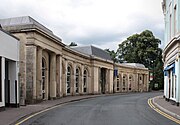
The Market Hall in Priory Street, Monmouth
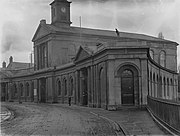
The Market Hall c.1905, prior to the loss of the upper storey and the cupola in a fire in 1963
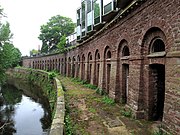
The Shambles (slaughterhouses) beneath the Market Hall
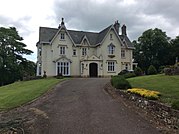
Pentwyn - Maddox's house at Rockfield
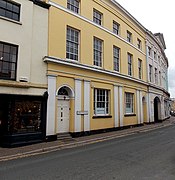
1–6 Priory Street - Maddox's "remarkably early inner by-pass"

The central block of 1-6 Priory Street
Notes[]
- ^ The attribution of No.18 to George Vaughan Maddox is uncertain. Cadw notes that the house is "said to have been designed by one of the Maddox family, but the doorway appears genuine 18th century."[14] Keith Kissack notes that Charles Heath, the Monmouth antiquarian, attributed the house to Maddox, but suggests that it may be by one of his family, rather than George Vaughan.[15]
- ^ Another instance of uncertainty as to which of the Maddox family may have been responsible for a structural design is the temple in the Nelson Garden on Monnow Street. The Nelson Garden Trust suggests George Maddox (1760-1843) as a possible designer and a construction date in the 1840s.[27] Cadw considers the building to be roughly contemporary with its house, No.18 Monnow, Street, which would place it very late in the 18th or very early in the 19th centuries, and suggests the property's owner, Philip Meakins Hardwick, as the likely designer.[28] Philip Bly, in his Guide to the complete Monmouth Heritage Blue Plaque Trail, suggests there were in fact two temples, and posits George Vaughan Maddox as the designer of the 1840's replacement.[29] John Newman does not suggest an architect but does comment on the structure's "most eccentric" design.[30]
References[]
- ^ a b Brodie 2001, p. 121.
- ^ a b Newman 2000, p. 394.
- ^ Kissack 1975, p. 298.
- ^ Public Architecture, House of Correction, Usk Archived 26 September 2012 at the Wayback Machine, accessed 19 January 2012; "the only son of James Maddox, a builder of Monmouth, and was doubtless related to George Maddox" (Howard Colvin, A Biographical Dictionary of British Architects, 1600–1840, 3rd ed. 1995, s.v. "Maddox, George Vaughan".
- ^ Cadw. "Nelson Museum, Local History Centre, and Monmouthshire County Council Area Office (Grade II) (2317)". National Historic Assets of Wales. Retrieved 12 September 2021.
- ^ Newman 2000, p. 44.
- ^ Cadw. "The Beaufort Arms Court (Grade II*) (2227)". National Historic Assets of Wales. Retrieved 12 September 2021.
- ^ Cadw. "Wesleyan Methodist Chapel (Grade II*) (2342)". National Historic Assets of Wales. Retrieved 12 September 2021.
- ^ NONCONFORMITY IN MONMOUTH, Newsletter No. 29, Capel, The Chapels Heritage Society, accessed January 2012
- ^ Cadw. "The Masonic Temple, including Tyler's Residence (Grade II) (2276)". National Historic Assets of Wales. Retrieved 12 September 2021.
- ^ Cadw. "Kingsley House (Grade II) (2275)". National Historic Assets of Wales. Retrieved 12 September 2021.
- ^ Cadw. "Hendre House (Grade II) (85015)". National Historic Assets of Wales. Retrieved 12 September 2021.
- ^ Cadw. "Oak House (Grade II) (2274)". National Historic Assets of Wales. Retrieved 12 September 2021.
- ^ a b Cadw. "No.18 St.James Street (Borough Offices) (Grade II) (2344)". National Historic Assets of Wales. Retrieved 12 September 2021.
- ^ Kissack 2003, p. 58.
- ^ Building permission Archived 10 March 2016 at the Wayback Machine, accessed January 2012
- ^ Newman 2000, pp. 405–6.
- ^ Bly 2012, p. 10.
- ^ Kissack 2003, p. xii.
- ^ Cadw. "Pentwyn (Grade II*) (87504)". National Historic Assets of Wales. Retrieved 12 September 2021.
- ^ Newman 2000, p. 516.
- ^ Cadw. "Croft-y-bwla (Grade II) (2371)". National Historic Assets of Wales. Retrieved 12 September 2021.
- ^ Newman 2000, p. 411.
- ^ Newman 2000, p. 250.
- ^ Newman 2000, p. 479.
- ^ Cadw. "Ruins of Piercefield House (Central Block) (Grade II*) (2013)". National Historic Assets of Wales. Retrieved 12 September 2021.
- ^ "Nelson Memorial Pavilion". Nelson Garden Trust. Retrieved 13 September 2021.
- ^ Cadw. "Lord Nelson's Seat in Nelson's Garden (Grade II*) (2290)". National Historic Assets of Wales. Retrieved 13 September 2021.
- ^ Bly 2012, p. 25.
- ^ Newman 2000, p. 409.
- ^ Newman 2000, p. 471.
Sources[]
- Bly, Phil (2012). Guide to the complete Monmouth Heritage Blue Plaque Trail. Monmouth: Monmouth Civic Society. OCLC 797974800.
- Brodie, Antonia (2001). Directory of British Architects 1834–1914: L–Z. Continuum International Publishing Group. ISBN 978-0-826-44963-4.
- Kissack, Keith (1975). Monmouth: The Making of a County Town. Chichester: Phillimore. ISBN 978-0-850-33209-4. OCLC 255539468.
- Kissack, Keith (2003). Monmouth and its Buildings. Woonton Almeley: Logaston Press. ISBN 978-1-904-39601-7. OCLC 55143853.
- Newman, John (2000). Gwent/Monmouthshire. The Buildings of Wales. London: Penguin. ISBN 978-0-300-09630-9.
- 1802 births
- 1864 deaths
- 19th-century Welsh architects
- Greek Revival architects
- History of Monmouthshire





